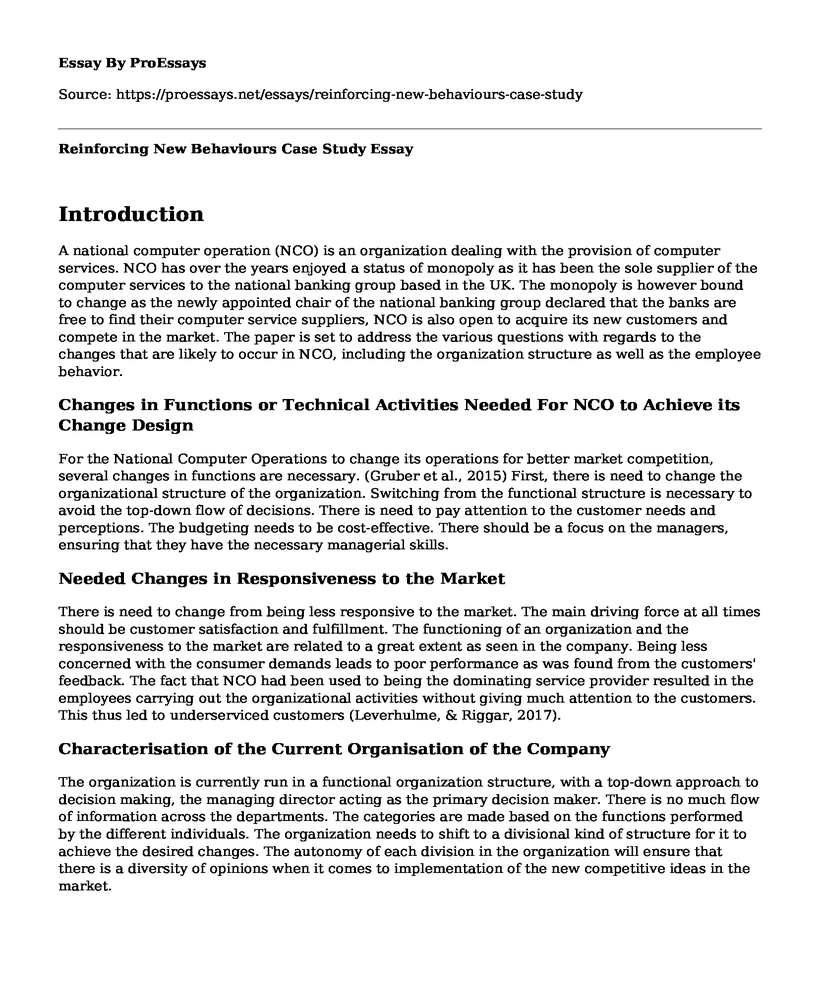Introduction
A national computer operation (NCO) is an organization dealing with the provision of computer services. NCO has over the years enjoyed a status of monopoly as it has been the sole supplier of the computer services to the national banking group based in the UK. The monopoly is however bound to change as the newly appointed chair of the national banking group declared that the banks are free to find their computer service suppliers, NCO is also open to acquire its new customers and compete in the market. The paper is set to address the various questions with regards to the changes that are likely to occur in NCO, including the organization structure as well as the employee behavior.
Changes in Functions or Technical Activities Needed For NCO to Achieve its Change Design
For the National Computer Operations to change its operations for better market competition, several changes in functions are necessary. (Gruber et al., 2015) First, there is need to change the organizational structure of the organization. Switching from the functional structure is necessary to avoid the top-down flow of decisions. There is need to pay attention to the customer needs and perceptions. The budgeting needs to be cost-effective. There should be a focus on the managers, ensuring that they have the necessary managerial skills.
Needed Changes in Responsiveness to the Market
There is need to change from being less responsive to the market. The main driving force at all times should be customer satisfaction and fulfillment. The functioning of an organization and the responsiveness to the market are related to a great extent as seen in the company. Being less concerned with the consumer demands leads to poor performance as was found from the customers' feedback. The fact that NCO had been used to being the dominating service provider resulted in the employees carrying out the organizational activities without giving much attention to the customers. This thus led to underserviced customers (Leverhulme, & Riggar, 2017).
Characterisation of the Current Organisation of the Company
The organization is currently run in a functional organization structure, with a top-down approach to decision making, the managing director acting as the primary decision maker. There is no much flow of information across the departments. The categories are made based on the functions performed by the different individuals. The organization needs to shift to a divisional kind of structure for it to achieve the desired changes. The autonomy of each division in the organization will ensure that there is a diversity of opinions when it comes to implementation of the new competitive ideas in the market.
Positive and Negative Effects on Employee's Behaviour, Perceived in the Current Organizational Structure
With strict rules and monitoring by management, the employees lack creativity and perform narrowly with lack of enthusiasm (Anderson, 2016). There exists an insular behavior which is brought about by categorization into different hierarchies. The classification has led to indifference where employees are not concerned with the interest of others in various bureaucracies or even the general interest of the organization but are instead concerned with their well-being. This structure can however positively impact the employee's behavior given the fact that people with common skills work together and therefore improve their skills.
Expected Change in Employer Behaviour as the Organisation Structure Changes
As the organizational structure changes to divisional, I expect the autonomy within the different divisions to make the employees more enthusiastic and ready to deliver. With teamwork, there is the likelihood of the workers to be responsive to the needs of the customers and to meet the overall goal of the organization. Decision-making approach shall change for the better, and every employer will feel included. This particular change will act as an initiative to improve the employer performance.
This plan is likely to reinforce the productivity of the employees while at the same time reducing the supervision and the production cost. The manager will feel more motivated and willing to deliver to the organization. The plan acts as a motivational incentive as the hardworking employee gets a reward and is encouraged to work even harder. The under-performing employees will also feel challenged as the others get to be awarded.
From the discussed responses, it is clear that NCO needs to do a lot of changes to compete in the market. The transformation in employee behavior is much required for NCO to deliver to its old and the new customers. Change in organization structure is likely to have an impact on the general employee behaviors.
References
Anderson, D. L. (2016). Organization development: The process of leading organizational change. Sage Publications.
Gruber, M., De Leon, N., George, G., & Thompson, P. (2015). Managing by design. Academy of Management Journal, 58(1), 1-7.
Leverhulme, L., & Riggar, T. F. (2017). Autonomy and control at the workplace: contexts for job redesign. Routledge.
Cite this page
Reinforcing New Behaviours Case Study. (2022, May 06). Retrieved from https://proessays.net/essays/reinforcing-new-behaviours-case-study
If you are the original author of this essay and no longer wish to have it published on the ProEssays website, please click below to request its removal:
- Management Essay Example: Shaping Cultures and Ethics of the Organization
- Knowledge Sharing in Decision-Making Essay
- Paper Example on Multiple and Diverse Decision Goals
- Strategic Management Paper Example: Case Study Analysis on Amazon
- Wal-Mart: A Cost Leader With Focus on Stakeholders - Essay Sample
- Essay Example on Social Advocacy: Working to End Discrimination
- Essay Example on Leaders: Values for Successful Organizations







